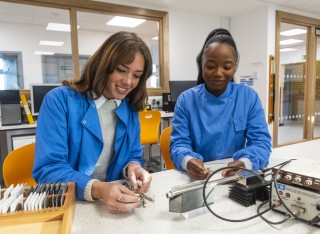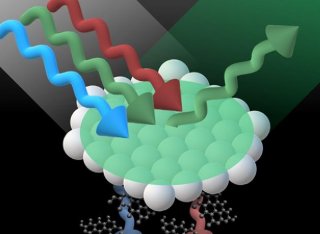
Dr Izabela Jurewicz
About
Biography
Dr Izabela Jurewicz is a senior lecturer at the University of Surrey and serves as Chief Scientific Officer for Advanced Material Development Ltd. With more than two decades of expertise in advanced materials research and engineering, Dr Jurewicz has built a distinguished career at the forefront of functional materials. She achieved her PhD in Physics from the University of Surrey in 2009, establishing a strong foundation for her specialisation in the field.
Dr Jurewicz has been awarded multiple grants and fellowships from prestigious bodies including EPSRC, UKRI, and Innovate UK, supporting her pioneering research and enabling the translation of key scientific breakthroughs into real-world industrial solutions. As a business hosted UKRI Future Leaders Fellow, she is renowned for her work in biomaterials and smart nanomaterials.
In her capacity as Chief Scientific Officer, she is widely recognised for spearheading innovation and successfully guiding the commercialisation of cutting-edge technologies, bridging the gap between academic research and market adoption. Most recently, she achieved notable success by contributing to licensing a vaccine vial monitor technology to a major pharmaceutical packaging manufacturer, further demonstrating the real-world impact of her research on healthcare logistics and product integrity.
My qualifications
News
Publications
High quality opal-like photonic crystals containing graphene are fabricated using evaporation-driven self-assembly of soft polymer colloids. A miniscule amount of pristine graphene within a colloidal crystal lattice results in the formation of colloidal crystals with a strong angle-dependent structural color and a stop band that can be reversibly shifted across the visible spectrum. The crystals can be mechanically deformed or can reversibly change color as a function of their temperature, hence their sensitive mechanochromic and thermochromic response make them attractive candidates for a wide range of visual sensing applications. In particular, we show that the crystals are excellent candidates for visual strain sensors or integrated time-temperature indicators which act over large temperature windows. Given the versatility of these crystals, this method represents a simple, inexpensive and scalable approach to produce multifunctional graphene infused synthetic opals and opens up exciting applications for novel solution-processable nanomaterial based photonics.
Here, we describe the unusual self-assembly of amine-terminated oligoglycine peptides into extended two-dimensional sheets in the presence of silver nanowires. The resulting tectomer sheets are shown to have a strong affinity for the nanowires through a charge-transfer interaction as evidenced by X-ray photoelectron spectroscopy. We show that extended assemblies of metal-peptide hybrids offer additional augmentative functionalities, for instance, the tectomer sheets are hydrophobic in nature and act as a protective layer preventing oxidation and degradation of the nanowires when exposed to atmospheric conditions. Moreover, for silver nanowire percolating networks the presence of the peptide markedly increases the overall electrical conductivity through mechanical squeezing of wire-wire junctions in the network. The peptide-metal interface can be controlled by pH stimulus thus potentially offering new directions where silver nanowire assemblies are used for transparent electrodes ranging from antimicrobial coatings to biosensors.
Amino-terminated oligoglycine two-dimensional (2D) peptide self-assemblies (known as tectomers) have a versatile surface chemistry that allows them to interact with a variety of nanomaterials and to act as supramolecular adhesives for surface functionalization. Here, we have exploited the strong hydrogen-bond based interaction between tectomers and graphene oxide (GO) to functionalize GO fiber surfaces with different carbon nanomaterials (carbon nanotubes, carbon nanohorns, carbon nanocones, and highly fluorescent nanodiamonds), metal (gold, platinum, iron) nanoparticles, acrylate-based polymer nanoparticles, fluorophores and drugs. The resulting ultrathin coatings exhibit remarkable water resistant properties. This tectomer-mediated fiber decoration strategy allows coating functionalities to be tailored by choosing the appropriate nanomaterials or other molecules. We show that this strategy can be extended to other fibers and fabrics, such as polyurethane/PEDOT:PSS, poly(methyl methacrylate) and polyester, making it very attractive for a variety of technological and smart textile applications.
We highlight the significance of capillary pressure in the directed assembly of nanorods in ordered arrays of colloidal particles. Specifically, we discuss mechanisms for the assembly of carbon nanotubes at the interstitial sites between latex polymer particles during composite film formation. Our study points to general design rules to be considered to optimize the ordering of nanostructures within such polymer matrices. In particular, gaining an understanding of the role of capillary forces is critical. Using a combination of electron microscopy and atomic force microscopy, we show that the capillary forces acting on the latex particles during the drying process are sufficient to bend carbon nanotubes. The extent of bending depends on the flexural rigidity of the carbon nanotubes and whether or not they are present as bundled ensembles. We also show that in order to achieve long-range ordering of the nanotubes templated by the polymer matrix, it is necessary for the polymer to be sufficiently mobile to ensure that the nanotubes are frozen into the ordered network when the film is formed and the capillary forces are no longer dominant. In our system, the polymer is plasticized by the addition of surfactant, so that it is sufficiently mobile at room temperature. Interestingly, the carbon nanotubes effectively act as localized pressure sensors, and as such, the study agrees well with previous theoretical predictions calculating the magnitude of capillary forces during latex film formation.
The effective growth of chondrocytes and the formation of cartilage is demonstrated on scaffolds of aligned carbon nanotubes; as two dimensional sheets and on three dimensional textiles. Raman spectroscopy is used to confirm the presence of chondroitin sulfate, which is critical in light of the unreliability of traditional dye based assays for carbon nanomaterial substrates. The textile exhibits a very high affinity for chondrocyte growth and could present a route to implantable, flexible cartilage scaffolds with tuneable mechanical properties.
Single or few layer graphene can be considered an exciting pseudo-two-dimensional molecular material that potentially has a wide range of applications. A critical bottleneck may arise with issues in their controlled assembly into macroscopic ensembles over large areas both in two and three dimensions. Langmuir-type assembly is a particularly useful method to control and manipulate the distribution of graphene at the air-water interface via edge-edge interactions. In this study, pristine graphene suspended in organic solvent was prepared through adaptation of a previously developed process involving the non-invasive exfoliation of graphite. Successful deposition of graphene at the air-water interface was achieved by manipulating the vapor-pressure of the graphene dispersion through solvent mixing. Through careful control of density, by following the pressure-area isotherm during monolayer compression, it is possible to precisely tune the electrical conductivity. The resulting assemblies can be easily transferred to glass and other substrates using the Langmuir-Schaefer horizontal deposition method producing thin films with tunable electrical conductivity that exhibits percolation-type behavior. A major advantage of this process is that the conducting films require no further treatment unlike their graphene-oxide counterparts. Moreover, the physical properties of these assemblies can be easily controlled which is a precursor for graphene-based electronic applications. © 2013 Elsevier Ltd. All rights reserved.
Nanoparticles of cerium dioxide (or nanoceria) are of interest because of their oxygen buffering, photocatalytic ability, and high UV absorption. For applications, the nanoceria can be incorporated in a polymer binder, but questions remain about the link between the nanoparticle distribution and the resulting nanocomposite properties. Here, the thermal, mechanical and optical properties of polymer/ceria nanocomposites are correlated with their nanostructures. Specifically, nanocomposites made from waterborne Pickering particles with nanoceria shells are compared to nanocomposites made from blending the equivalent surfactant-free copolymer particles with nanoceria. Two types of nanoceria (protonated or citric acid-coated) are compared in the Pickering particles. A higher surface coverage is obtained with the protonated ceria, which results in a distinct cellular structure with nanoceria walls within the nanocomposite. In the blend of particles, a strong attraction between the protonated nanoceria and the acrylic acid groups of the copolymer likewise leads to a cellular structure. This structure offers transparency in the visible region combined with strong UV absorption, which is desired for UV blocking coating applications. Not having an attraction to the polymer, the citric acid-coated nanoceria forms agglomerates that lead to undesirable light scattering in the nanocomposite and yellowing. This latter type of nanocomposite coating is less effective in protecting substrates from UV damage but provides a better barrier to water. This work shows how the nanoparticle chemical functionalization can be used to manipulate the structure and to tailor the properties of UV-absorbing barrier coatings.
A significant reduction in the electrical percolation threshold is achieved by locking carbon nanotubes (CNTs) in a predominantly hexagonally close-packed (HCP) colloidal crystal lattice of partially plasticized latex particles. Contrary to other widely used latex processing where CNTs are randomly distributed within the latex matrix, for the first time, we show that excluding CNTs from occupying the interior volume of the latex particles promotes the formation of a nonrandom segregated network. The electrical percolation threshold is four times lower in an ordered segregated network made with colloidal particles near their glass transition temperature (T(g)) in comparison to in a random network made with particles at a temperature well above the T(g). This method allows for a highly reproducible way to fabricate robust, stretchable, and electrically conducting thin films with significantly improved transparency and lattice percolation at a very low CNT inclusion which may find applications in flexible and stretchable electronics as well as other stretchable technologies. For instance, our technology is particularly apt for touch screen applications, where one needs homogeneous distribution of the conductive filler throughout the matrix.
Novel synthetic biomaterials able to support, direct tissue growth and retain cellular phenotypical properties are promising building blocks for the development of tissue engineering platforms for accurate and fast therapy screening for cancer. The aim of this study is to validate an aligned, pristine multi-walled carbon nanotube (CNT) platform for in vitro studies of pancreatic cancer as a systematic understanding of interactions between cells and these CNT substrates is lacking. Our results demonstrate that our CNT scaffolds -which are easily tuneable to form sheets/fibres- support growth, proliferation and spatial organisation of pancreatic cancer cells, indicating their great potential in cancer tissue engineering.
Over the past several years a great deal of research has focused on the adaptation of carbon nanotubes (CNTs) for a wide range of applications, including as gas detectors, in energy storage, for various photonics purposes, also as radiation sensors. In previous studies by this group, investigating thermoluminescent (TL) properties, the sensitivity of CNTs towards ionising radiations has been observed using beta radiation at dose levels from fractions of a Gy and more. Strain and impurity defects in CNTs give rise to substantial TL yields, the extent to which electron trapping centres exist varying inversely with the quality of CNT, from super-pure to pure to raw. In present study the contribution to TL of beta particle irradiated CNTs has been investigated with respect to changes in the lattice atomic orbitals, pointing to the possibility of a new radiation dosimetry method. The surface-sensitive method, one highly suited to the thin (few tens of pm thick) CNT samples produced in the form of free-standing buckypaper, is based on use of the X-Ray Photoelectron Spectroscopy (XPS) technique, evaluating sp(2) to sp(3) hybridisation. The CNT samples have been examined subsequent to irradiation using a relatively large activity Sr-90/Y-90 radionuclide source (E-beta = 0.546 MeV/2.28 MeV), delivering doses in the range 0.2-6 Gy, in all three qualities sp(2) to sp(3) hybridisation being observed to increase with dose deposition. Considerable advantage is seen in making use of such thin CNTs in dosimetry, rendering them particularly suitable for beta particle soft tissue dosimetry.
Here we present a route for non‐covalent functionalization of carboxylated multi‐wall carbon nanotubes and graphene oxide with novel two‐dimensional peptide assemblies. We show that self‐assembled amino‐terminated biantennary and tetraantennary oligoglycine peptides (referred to as tectomers) effectively coat carboxylated multi‐walled carbon nanotubes and also strongly interact with graphene oxide due to electrostatic interactions and hydrogen bonding as the driving force, respectively. The resulting hybrids can be made into free‐standing conducting composites or applied in the form of thin, pH‐switchable bioadhesive coatings onto graphene oxide fibers. Monitoring of cell viability of pancreatic cell lines, seeded on those CNT hybrids, show that they can be used as two‐ and three‐dimensional scaffolds to tissue engineer tumour models for studying ex vivo the tumour development and response to treatment. This highly versatile method in producing pH‐responsive hybrids and coatings offers an attractive platform for a variety of biomedical applications and for the development of functional materials such as smart textiles, sensors and bioelectronic devices.
The nanocarrier capabilities of atomically smooth two-dimensional sheets of a biantennary oligoglycine peptide C8H16(−CH2–NH–Gly5)2 (also called tectomers) are demonstrated. We show that the pH-controlled, rapid, and reversible assembly and disassembly of oligoglycine can be effectively used for controlled loading and release of the anticancer drug and fluorescent probe coralyne. The calculated partition coefficient in water is of the same order of magnitude or higher when compared to other nanocarriers such as liposomes and micelles, signifying the tectomer’s impressive loading capabilities. Moreover, the loading of guest molecules in tectomers facilitates the protection from rapid photochemically induced degradation. Such efficient, pH-sensitive, stable, and biocompatible nanocarriers are extremely attractive for biosensing, therapeutic, and theranostic applications. Additionally, our results suggest that these planar self-assembled materials can also act as phase-transfer vehicles for hydrophobic cargoes further broadening their biomedical and technological applications.
A variety of two-dimensional (2D) nanomaterials, including graphene oxide and clays, are known to stabilize Pickering emulsions to fabricate structures for functions in sensors, catalysts, and encapsulation. We introduce here a novel Pickering emulsion using self-assembled amphiphilic triblock oligoglycine as the emulsifier. Peptide amphiphiles are more responsive to environmental changes (e.g., pH, temperature, and ionic strength) than inorganic 2D materials, which have a chemically rigid, in-plane structure. Noncovalent forces between the peptide molecules change with the environment, thereby imparting responsiveness. We provide new evidence that the biantennary oligoglycine, Gly4–NH–C10H20–NH–Gly4, self-assembles into 2D platelet structures, denoted as tectomers, in solution at a neutral buffered pH using small-angle X-ray scattering and molecular dynamics simulations. The molecules are stacked in the platelets with a linear conformation, rather than in a U-shape. We discovered that the lamellar oligoglycine platelets adsorbed at an oil/water interface and stabilized oil-in-water emulsions. This is the first report of 2D oligoglycine platelets being used as a Pickering stabilizer. The emulsions showed a strong pH response in an acidic environment. Thus, upon reducing the pH, the protonation of the terminal amino groups of the oligoglycine induced disassembly of the lamellar structure due to repulsive electrostatic forces, leading to emulsion destabilization. To demonstrate the application of the material, we show that a model active ingredient, β-carotene, in the oil is released upon decreasing the pH. Interestingly, in pH 9 buffer, the morphology of the oil droplets evolved over time, as the oligoglycine stabilizer created progressively a thicker interfacial layer. This demonstration opens a new route to use self-assembled synthetic peptide amphiphiles to stabilize Pickering emulsions, which can be significant for biomedical and pharmaceutical applications.
Oil-in-water emulsions, stabilised with conventional surfactants, are commonly used in eye drops for ocular drug delivery. However, the presence of surfactants can sometimes irritate tissues. Furthermore, conventional emulsions often have poor retention on ocular tissue. Pickering emulsions stabilised with nanoparticles have been gaining attention in recent years for a range of biomedical applications because of their biocompatibility. Here, Pickering emulsions were evaluated for the first time for the confinement of organic components for potential application in ocular drug delivery. For a model system, we used nanodiamond (ND) nanoparticles functionalised with covalently-bonded two-tail (2T) oligoglycine C-10(NGly(4))(2) to make Pickering oil-in-water emulsions, which were stable over three months of storage under neutral pH. We proved the non-toxicity of ND-2T Pickering emulsions, comparable to buffer solution, via an ex vivo bovine corneal permeability and opacity test. The retention of the oil phase in the ND-2T stabilised emulsions on corneal tissue is significantly increased because of the mucoadhesive properties arising from the positively-charged terminal amino groups of 2T. Our formulated emulsions have a surface tension, pH and salt concentration comparable to that of tear fluid. The high retention of the ND-2T-stabilised emulsions on the corneal surface, in combination with their non-toxicity, gives them distinct advantages for ocular drug delivery. The principles of this model system could be applied in the future design of a range of formulations for drug delivery.
There is a growing interest in 2D materials-based devices as the replacement for established materials, such as silicon and metal oxides in microelectronics and sensing, respectively. However, the atomically thin nature of 2D materials makes them susceptible to slight variations caused by their immediate environment, inducing doping and strain, which can vary between, and even microscopically within, devices. One of the misapprehensions for using 2D materials is the consideration of unanimous intrinsic properties over different support surfaces. The interfacial interaction, intrinsic structural disorder and external strain modulate the properties of 2D materials and govern the device performance. The understanding, measurement and control of these factors are thus one of the significant challenges for the adoption of 2D materials in industrial electronics, sensing, and polymer composites. This topical review provides a comprehensive overview of the effect of strain-induced lattice deformation and its relationship with physical and electronic properties. Using the example of graphene and MoS2 (as the prototypical 2D semiconductor), we rationalise the importance of scanning probe techniques and Raman spectroscopy to elucidate strain and doping in 2D materials. These effects can be directly and accurately characterised through Raman shifts in a non-destructive manner. A generalised model has been presented that deconvolutes the intertwined relationship between strain and doping in graphene and MoS2 that could apply to other members of the 2D materials family. The emerging field of straintronics is presented, where the controlled application of strain over 2D materials induces tuneable physical and electronic properties. These perspectives highlight practical considerations for strain engineering and related microelectromechanical applications.
We report the first application of finite-size scaling theory to nanostructured percolating networks, using silver nanowire (AgNW) films as a model system for experiment and simulation. AgNWs have been shown to be a prime candidate for replacing Indium Tin Oxide (ITO) in applications such as capacitive touch sensing. While their performance as large area films is well-studied, the production of working devices involves patterning of the films to produce isolated electrode structures, which exhibit finite-size scaling when these features are sufficiently small. We demonstrate a generalised method for understanding this behaviour in practical rod percolation systems, such as AgNW films, and study the effect of systematic variation of the length distribution of the percolating material. We derive a design rule for the minimum viable feature size in a device pattern, relating it to parameters which can be derived from a transmittance– sheet resistance data series for the material in question. This understanding has direct implications for the industrial adoption of silver nanowire electrodes in applications where small features are required including single-layer capacitive touch sensors, LCD and OLED display panels
Heterostructures of two-dimensional (2D) materials using graphene and MoS2 have enabled both pivotal fundamental studies and unprecedented sensing properties. These heterosystems are intriguing when graphene and MoS2 are interfaced with 2D sheets that emulate biomolecules, such as amino-terminated oligoglycine self-assemblies (known as tectomers). The adsorption of tectomer sheets over graphene and MoS2 modulates the physicochemical properties through electronic charge migration and mechanical stress transfer. Here, we present a systematic study by Raman spectroscopy and tectomer-functionalised scanning probe microscopy to understand mechanical strain, charge transfer and binding affinity in tectomer/graphene and tectomer/MoS2 hybrid structures. Raman mapping reveals distinctive thickness dependence of tectomer-induced charge transfer to MoS2, showing p-doping on monolayer MoS2 and n-doping on multilayer MoS2. By contrast, graphene is n-doped by tectomer independently of layer number, as confirmed by x-ray photoelectron spectroscopy. The interfacial adhesion between the amino groups and 2D materials are further explored using tectomer-functionalised probe microscopy. It is demonstrated here that these probes have potential for chemically sensitive imaging of 2D materials, which will be useful for mapping chemically distinct domains of surfaces and the number of layers. The facile tectomer-coating approach described here is an attractive soft-chemistry strategy for high-density amine-functionalisation of atomic force microscopy probes, therefore opening promising avenues for sensor applications.
Dosimetry devices based on Carbon Nanotubes are a promising new technology. In particular using devices based on single wall carbon nanotubes may offer a tissue equivalent response with the possibility for device miniaturisation, high scale manufacturing and low cost. An important precursor to device fabrication requires a quantitative study of the effects of X-ray radiation on the physical and chemical properties of the individual nanotubes. In this study, we concentrate on the effects of relatively low doses, 20 cGy and 45 cGy, respectively. We use a range of characterization techniques including scanning electron microscopy, Raman spectroscopy and X-ray photoelectron spectroscopy to quantify the effects of the radiation dose on inherent properties of the nanotubes. Specifically we find that the radiation exposure results in a reduction in the sp2 nature of the nanotube bond structure. Moreover, our analysis indicates that the exposure results in nanotubes that have an increased defect density which ultimately effects the electrical properties of the nanotubes.
Graphite ion chambers and semiconductor diode detectors have been used to make measurements in phantoms but these active devices represent a clear disadvantage when considered for in vivo dosimetry. In such circumstance, dosimeters with atomic number similar to human tissue are needed. Carbon nanotubes have properties that potentially meet the demand, requiring low voltage in active devices and an atomic number similar to adipose tissue. In this study, single-wall carbon nanotubes (SWCNTs) buckypaper has been used to measure the beta particle dose deposited from a strontium-90 source, the medium displaying thermoluminescence at potentially useful sensitivity. As an example, the samples show a clear response for a dose of 2Gy. This finding suggests that carbon nanotubes can be used as a passive dosimeter specifically for the high levels of radiation exposures used in radiation therapy. Furthermore, the finding points towards further potential applications such as for space radiation measurements, not least because the medium satisfies a demand for light but strong materials of minimal capacitance.
We demonstrate that the optoelectronic properties of percolating thin films of silver nanowires (AgNWs) are predominantly dependent upon the length distribution of the constituent AgNWs. A generalized expression is derived to describe the dependence of both sheet resistance and optical transmission on this distribution. We experimentally validate the relationship using ultrasonication to controllably vary the length distribution. These results have major implications where nanowire-based films are a desirable material for transparent conductor applications; in particular when application-specific performance criteria must be met. It is of particular interest to have a simple method to generalize the properties of bulk films from an understanding of the base material, as this will speed up the optimisation process. It is anticipated that these results may aid in the adoption of nanowire films in industry, for applications such as touch sensors or photovoltaic electrode structures.
Hypothesis Surfactants in emulsions sometimes do not provide adequate stability against coalescence, whereas Pickering emulsions often offer greater stability. In a search for stabilizers offering biocompatibility, we hypothesized that carboxylated nanodiamonds (ND) would impart stability to Pickering emulsions. Experiments We successfully prepared Pickering emulsions of sunflower oil in water via two different methods: membrane emulsification and probe sonication. The first method was only possible when the pH of the aqueous ND suspension was ≤4. Findings Pendant-drop tensiometry confirmed that carboxylated ND is adsorbed at the oil/water interface, with a greater decrease in interfacial tension found with increasing ND concentrations in the aqueous phase. The carboxylated ND become more hydrophilic with increasing pH, according to three-phase contact angle analysis, because of deprotonation of the carboxylic acid groups. Membrane emulsification yielded larger (about 30 µm) oil droplets, probe sonication produced smaller (sub-μm) oil droplets. The Pickering emulsions show high stability against mechanical vibration and long-term storage for one year. They remain stable against coalescence across a wide range of pH values. Sonicated emulsions show stability against creaming. In this first-ever systematic study of carboxylated ND-stabilized Pickering emulsions, we demonstrate a promising application in the delivery of β-carotene, as a model active ingredient.
Electrical conductivity is of great significance to cardiac tissue engineering and permits the use of electrical stimulation in mimicking cardiac pacing. The development of biomaterials for tissue engineering can incorporate physical properties that are uncommon to standard cell culture and can facilitate improved cardiomyocyte function. In this review, the PICOT question asks, "How has the application of external electrical stimulation in conductive scaffolds for tissue engineering affected cardiomyocyte behavior in in vitro cell culture?" The Preferred Reporting Items for Systematic Reviews and Meta-Analysis guidelines, with predetermined inclusion and quality appraisal criteria, were used to assess publications from PubMed, Web of Science, and Scopus. Results revealed carbon nanotubes to be the most common conductive agent in biomaterials and rodent-sourced cell types as the most common cardiomyocytes used. To assess cardiomyocytes, immunofluorescence was used most often, utilizing proteins, such as connexin 43, cardiac α-actinin, and cardiac troponins. It was determined that the modal average stimulation protocol comprised 1-3 V square biphasic 50-ms pulses at 1 Hz, applied toward the end of cell culture. The addition of electrical stimulation to in vitro culture has exemplified it as a powerful tool for cardiac tissue engineering and brings researchers closer to creating optimal artificial cardiac tissue constructs.
We report on the first use OF carbon-nanotube-based films to produce crystals of proteins. The crystals nucleate on the surface of the film. The difficulty of crystallizing proteins is a major bottleneck in. the determination of the structure and function of biological molecules. The crystallization of two model proteins and two medically relevant proteins was studied. Quantitative data on the crystallization times of the model protein lyozyme are also presented. Two types of nanotube films, one made with the surfactant Triton X-100 (TX-100) and one with gelatin, were tested. Both induce nucleation of the crystal phase at supersaturations at which the protein solution would otherwise remain clear: however, the gelatin-based film induced nucleation down to much lower supersaturations for the two model proteins with which it was used. it appears that the interactions of gelatin with the protein molecules are particularly favorable to nucleation. Crystals of the C I domain of the human cardiac myosin-binding protein-C that diffracted to a resolution of 1.6 angstrom were obtained on the TX-100 film. This is far superior to the best crystals obtained using standard techniques, which only diffracted to 3.0 angstrom. Thus, both of our nanotube-based films are very promising candidates for future work on crystallizing difficult-to-crystallize target proteins.
Cardiovascular disease is currently the top global cause of death, however, research into new therapies is in decline. Tissue engineering is a solution to this crisis and in combination with the use of carbon nanotubes (CNTs), which have drawn recent attention as a biomaterial, could facilitate the development of more dynamic and complex in vitro models. CNTs' electrical conductivity and dimensional similarity to cardiac extracellular proteins provide a unique opportunity to deliver scaffolds with stimuli that mimic the native cardiac microenvironment in vitro more effectively. This systematic review aims to evaluate the use and efficacy of CNTs for cardiac tissue scaffolds and was conducted according to the Preferred Reporting Items for Systematic Reviews and Meta-Analysis (PRISMA) guidelines. Three databases were searched: PubMed, Scopus, and Web of Science. Papers resulting from these searches were then subjected to analysis against pre-determined inclusion and quality appraisal criteria. From 249 results, 27 manuscripts met the criteria and were included in this review. Neonatal rat cardiomyocytes were most commonly used in the experiments, with multi-walled CNTs being most common in tissue scaffolds. Immunofluorescence was the experimental technique most frequently used, which was employed for the staining of cardiac-specific proteins relating to contractile and electrophysiological function.
Here, we present an approach to incorporate graphene nanosheets into a silicone rubber matrix via solid stabilization of oil-in-water emulsions. These emulsions can be cured into discrete, graphenecoated silicone balls or continuous, elastomeric films by controlling the degree of coalescence. We characterize the electromechanical properties of the resulting composites as a function of interdiffusion time and graphene loading level. With conductivities approaching 1 S m-1, elongation to break up to 160% and a gauge factor of ~20 in the low-strain linear regime, we can accurately measure small strains such as pulse. At higher strains, the electromechanical response exhibits a robust exponential dependence, allowing accurate readout for higher strain movements such as chest motion and joint bending. The exponential gauge factor is found to be ~20, independent of loading level and valid up to 80% strain; this consistent performance is due to the emulsiontemplated microstructure of the composites. The robust behavior may facilitate high-strain sensing in the non-linear regime using nanocomposites, where relative resistance change values in excess of 107 enable highly accurate bodily motion monitoring.
Two-dimensional titanium carbide (Ti3C2Tx), or MXene, is a new nanomaterial that has attracted increasing interest due to its metallic conductivity, good solution processability, and excellent energy storage performance. However, Ti3C2Tx MXene flakes suffer from degradation through oxidation due to prolonged exposure to oxygenated water. Preventing the occurrence of oxidation i.e. the formation of TiO2 particles, was found to be the crucial to maintain MXene quality. In present work, we found that freezing aqueous MXene dispersions at low-temperature can effectively prevents the formation of TiO2 nanoparticles at the flake edge, which is known as the early stage of oxidation. The Ti3C2Tx flakes in frozen dispersion remains consistent in morphology and elemental composition for over 650 days, compared with freshly synthesized MXene; which in contrast, exhibits flake edge degradation within two days when stored at room temperature. This result suggests that freezing MXene dispersion dramatically postpones the oxidation of MXene flakes and the stored MXene dispersion can be treated as freshly prepared MXene. This work not only fundamentally fulfilled the study on temperature dependence of MXene oxidation, but has also demonstrated a simple method to extend the shelf life of MXene aqueous dispersion to years, which will be a cornerstone for large scale production of MXene and ultimately benefit the research on MXenes.
Graphene and other graphitic materials are suggested as a route to cheap, high‐performance, environmentally‐sustainable electronic devices owing to their almost unique combination of properties. Liquid‐phase exfoliation is a family of shear‐based techniques that produce dispersions of nanosheets from bulk layered material crystallites. High‐quality nanosheets of graphene can be produced in solvents or surfactant dispersions; however the lateral size of these sheets limits the network transport properties observed in printed films. A high‐throughput, industrially‐scalable aqueous process for the production of graphene and related layered nanomaterials is presented. By considering not only the exfoliation process, but also the size selection and deposition processes, printable graphitic nanoparticulate materials with conductivities up to 50 000 S m−1 are demonstrated. This value is ten times larger than is typically obtained for few‐layer graphene produced by liquid‐phase exfoliation. The size selection process is critical to obtaining the maximum conductivity of deposited films, with an optimized nanographite having greater performance than few‐layer graphene or graphite that is processed and used without size selection. Building on these results a radio‐frequency antenna application is demonstrated, which is competitive with the state‐of‐the‐art, and a route to recycling of such printed short‐lifetime electronic devices to lower the environmental impact is discussed.
Silver nanowire networks emerged recently as a remarkable substitute for indium tin oxide (ITO) trans-parent electrodes. Here we show that this silver nanowire alternative can be successfully processed using the same laser ablation technique commonly used to manufacture ITO devices. As a proof of concept, we have manufactured a fully operating five inch multi-touch highly-pixelated sensor typically used in smartphone technology and find it to perform comparably to one based on ITO. We observe that laser processing silver nanowire films is much more efficient from an energy point of view, with scribes hardly visible to the naked eye. We find that the sheet resistance (RS) of the nanowire films increases as a result of dividing it into finite geometries and supported by simulation data, we predict over which length scales this affect becomes significant. Our results point to the viability of using such nanowire systems as an alternative to more traditional technologies in touch sensor design while highlighting some of the challenges to be addressed.
Here we culture Chinese hamster ovary cells on isotropic, aligned and patterned substrates based on multiwall carbon nanotubes. The nanotubes provide the substrate with nanoscale topography. The cells adhere to and grow on all substrates, and on the aligned substrate, the cells align strongly with the axis of the bundles of the multiwall nanotubes. This control over cell alignment is required for tissue engineering; almost all tissues consist of oriented cells. The aligned substrates are made using straightforward physical chemistry techniques from forests of multiwall nanotubes; no lithography is required to make inexpensive large-scale substrates with highly aligned nanoscale grooves. Interestingly, although the cells strongly align with the nanoscale grooves, only a few also elongate along this axis: alignment of the cells does not require a pronounced change in morphology of the cell. We also pattern the nanotube bundles over length scales comparable to the cell size and show that the cells follow this pattern.
There is a significant need to understand the complexity and heterogeneity of articular cartilage to develop more effective therapeutic strategies for diseases such as osteoarthritis. Here, we show that carbon nanotubes (CNTs) are excellent candidates as a material for synthetic scaffolds to support the growth of chondrocytes—the cells that produce and maintain cartilage. Chondrocyte morphology, proliferation, and alignment were investigated as nanoscale CNT networks were applied to macroscopically textured polydimethylsiloxane (PDMS) scaffolds. The application of CNTs to the surface of PDMS-based scaffolds resulted in an up to 10-fold increase in cell adherence and 240% increase in proliferation, which is attributable to increased nanoscale roughness and hydrophilicity. The introduction of macroscale features to PDMS induced alignment of chondrocytes, successfully mimicking the cell behavior observed in the superficial layer of cartilage. Raman spectroscopy was used as a noninvasive, label-free method to monitor extracellular matrix production and chondrocyte phenotype. Chondrocytes on these scaffolds successfully produced collagen, glycosaminoglycan, and aggrecan. This study demonstrates that introducing physical features at different length scales allows for a high level of control over tissue scaffold design and, thus, cell behavior. Ultimately, these textured scaffolds can serve as platforms to improve the understanding of osteoarthritis and for early-stage therapeutic testing.
Ultrasonication is the most widely used technique for the dispersion of a range of nanomaterials, but the intrinsic mechanism which leads to stable solutions is poorly understood with procedures quoted in the literature typically specifying only extrinsic parameters such as nominal electrical input power and exposure time. Here we present new insights into the dispersion mechanism of a representative nanomaterial, single-walled carbon nanotubes (SW-CNTs), using a novel up-scalable sonoreactor and an in situ technique for the measurement of acoustic cavitation activity during ultrasonication. We distinguish between stable cavitation, which leads to chemical modification of the surface of the CNTs, and inertial cavitation, which favors CNT exfoliation and length reduction. Efficient dispersion of CNTs in aqueous solution is found to be dominated by mechanical forces generated via inertial cavitation, which in turn depends critically on surfactant concentration. This study highlights that careful measurement and control of cavitation rather than blind application of input power is essential in the large volume production of nanomaterial dispersions with tailored properties.
In this work we present silver nanowire hybrid electrodes, prepared through the addition of small quantities of pristine graphene by mechanical transfer deposition from surface-assembled Langmuir films. This technique is a fast, efficient, and facile method for modifying the opto-electronic performance of AgNW films. We demonstrate that it is possible to use this technique to perform two-step device production by selective patterning of the stamp used, leading to controlled variation in the local sheet resistance across a device. This is particularly attractive for producing extremely low-cost sensors on arbitrarily large scales. Our aim is to address some of the concerns surrounding the use of AgNW films as replacements for indium tin oxide (ITO); namely the use of scarce materials and poor stability of AgNWs against flexural and environmental degradation.
Laser-deposited carbon aerogel is a low-density porous network of carbon clusters synthesized using a laser process. A one-step synthesis, involving deposition and annealing, results in the formation of a thin porous conductive film which can be applied as a chemiresistor. This material is sensitive to NO2 compared to ammonia and other volatile organic compounds and is able to detect ultra-low concentrations down to at least 10 parts-per-billion. The sensing mechanism, based on the solubility of NO2 in the water layer adsorbed on the aerogel, increases the usability of the sensor in practically-relevant ambient environments. A heating step, achieved in tandem with a microheater, allows the recovery to the baseline making it operable in real world environments. The operability at room temperature, its low cost and scalable production makes it promising for Internet-of-Things air quality monitoring.





